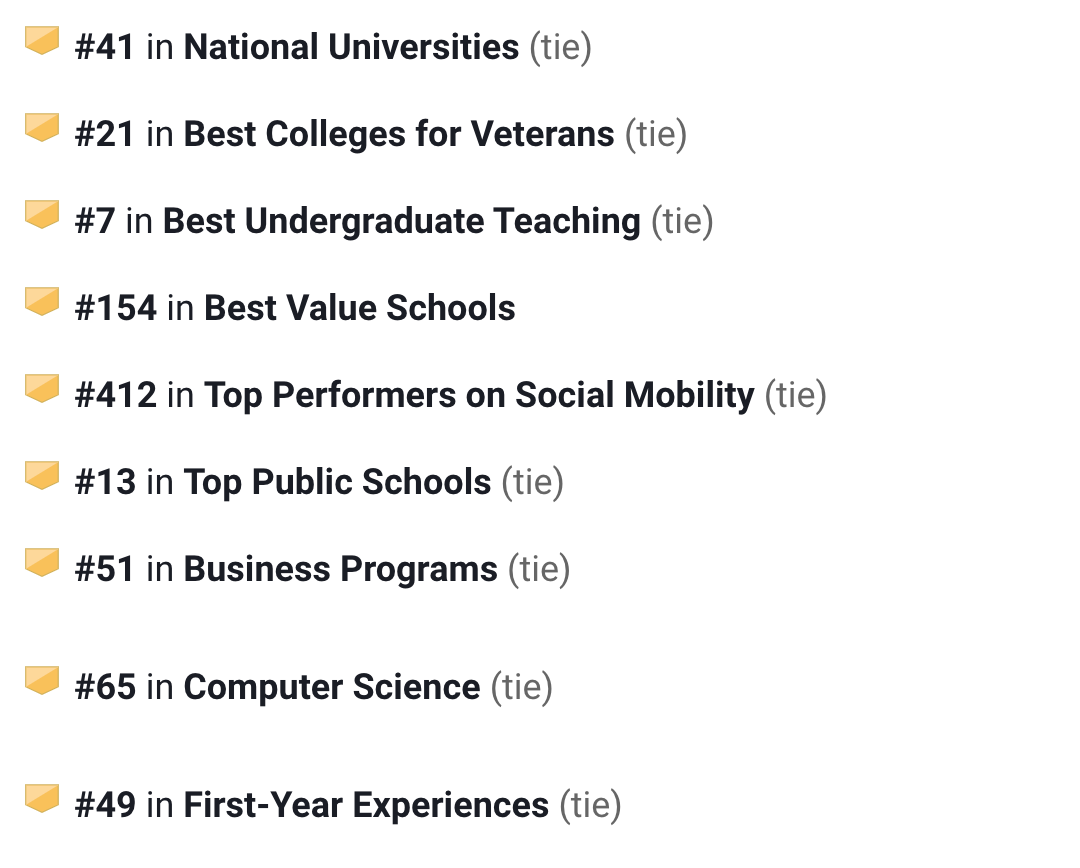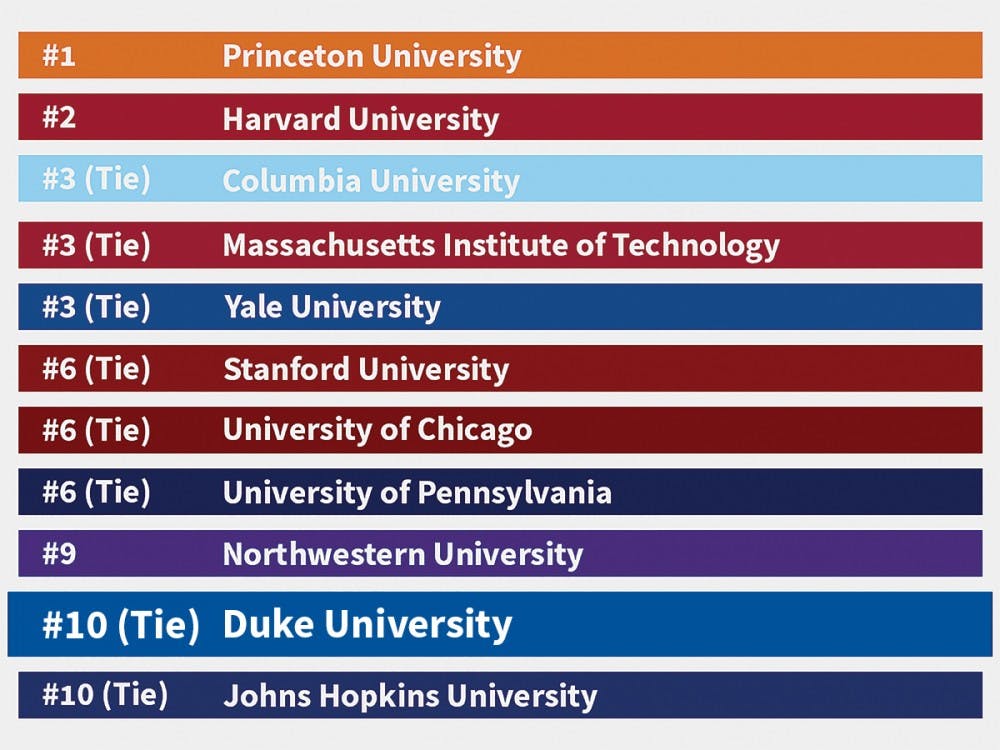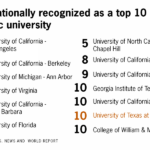Us news public university ranking – The US News & World Report public university ranking is a highly influential metric in the higher education landscape. This annual ranking, based on a comprehensive methodology, evaluates institutions across a range of criteria, including academic reputation, faculty resources, student selectivity, and graduation rates. The ranking has become a significant factor for prospective students, institutions, and even policymakers, shaping perceptions and influencing decisions.
Understanding the nuances of the US News & World Report ranking system is crucial for anyone navigating the complex world of higher education. This guide will delve into the methodology behind the rankings, explore the top public universities, and analyze the impact these rankings have on students, institutions, and the broader higher education landscape.
Understanding the Rankings
The US News & World Report’s annual public university rankings have become a highly influential factor in the higher education landscape. These rankings aim to provide a comprehensive evaluation of institutions, helping prospective students, their families, and even policymakers make informed decisions. However, understanding the methodology behind these rankings is crucial to interpreting their significance accurately.
Methodology and Criteria
The US News & World Report’s methodology for ranking public universities is a complex process that involves several factors. These factors are grouped into categories, each contributing to the overall score. The main criteria considered are:
- Academic Reputation: This is based on a survey of college presidents, provosts, and deans. It measures the perception of an institution’s academic quality within the higher education community.
- Faculty Resources: This category evaluates the quality of faculty, including factors like faculty salaries, student-to-faculty ratio, and the number of faculty with the highest degrees in their fields.
- Student Selectivity: This criterion assesses the academic qualifications of incoming students, taking into account factors like SAT/ACT scores, high school GPA, and acceptance rates.
- Graduation and Retention Rates: These measures reflect the institution’s success in graduating students and retaining them throughout their studies. A higher graduation rate indicates a strong commitment to student success and a supportive academic environment.
- Financial Resources: This category considers factors like per-student spending on instruction, the percentage of students receiving financial aid, and the endowment size. It reflects the institution’s ability to invest in its students and provide them with adequate resources.
- Alumni Giving: This criterion measures the level of alumni engagement and support for the institution. A high alumni giving rate indicates a strong sense of community and a positive alumni experience.
Historical Context and Impact
The US News & World Report rankings have been published annually since 1983, and their influence has grown significantly over the years. These rankings have become a major source of information for prospective students and their families, influencing their college choices. However, the impact of these rankings on higher education institutions goes beyond student recruitment.
- Increased Competition: The rankings have intensified competition among universities, leading them to focus on metrics that improve their ranking positions. This can lead to an emphasis on certain criteria, potentially at the expense of other important aspects of education.
- Pressure to Improve: Institutions strive to improve their rankings, often leading to significant investments in resources, faculty, and infrastructure. While this can benefit students, it can also create pressure on faculty and administrators to prioritize rankings over other educational goals.
- Focus on Prestige: The rankings have contributed to a focus on prestige and reputation, sometimes overshadowing the importance of a well-rounded education. This can lead to an emphasis on highly selective programs and research-intensive institutions, potentially neglecting the needs of students pursuing other educational paths.
Top Public Universities
The US News & World Report rankings are a widely recognized and influential measure of university quality in the United States. These rankings are based on a variety of factors, including academic reputation, faculty resources, student selectivity, and graduation rates. While these rankings are not the only measure of a university’s success, they provide a valuable insight into the institutions that consistently excel in higher education.
Top 10 Public Universities
The following table lists the top 10 public universities in the US according to the US News & World Report rankings for the 2023-2024 academic year:
| Rank | University | Location | Notable Academic Programs |
|---|---|---|---|
| 1 | University of California, Berkeley | Berkeley, CA | Engineering, Law, Public Policy |
| 2 | University of California, Los Angeles | Los Angeles, CA | Medicine, Theater, Film |
| 3 | University of Michigan | Ann Arbor, MI | Business, Engineering, Law |
| 4 | University of Wisconsin-Madison | Madison, WI | Business, Engineering, Agriculture |
| 5 | University of Virginia | Charlottesville, VA | Law, Public Policy, History |
| 6 | University of Washington | Seattle, WA | Medicine, Engineering, Computer Science |
| 7 | University of Illinois at Urbana-Champaign | Urbana, IL | Engineering, Business, Agriculture |
| 8 | University of California, San Diego | San Diego, CA | Medicine, Engineering, Oceanography |
| 9 | University of North Carolina at Chapel Hill | Chapel Hill, NC | Medicine, Business, Law |
| 10 | Cornell University | Ithaca, NY | Agriculture, Engineering, Hospitality |
Factors Contributing to Success
Several factors contribute to the success of these top public universities. These include:
- Strong Research Funding: These universities receive substantial funding from both public and private sources, allowing them to attract top faculty, invest in cutting-edge research, and provide students with access to state-of-the-art facilities.
- Distinguished Faculty: These institutions boast renowned faculty members who are leaders in their respective fields. Their expertise and dedication to teaching and research contribute significantly to the academic quality of these universities.
- Robust Alumni Networks: The alumni of these universities form strong networks that offer valuable career opportunities and support to current students. These networks are a testament to the long-lasting impact these institutions have on their graduates.
- Selective Admissions: These universities have highly selective admissions processes, ensuring that they attract and enroll a diverse and talented student body. This selectivity contributes to the overall academic rigor and intellectual environment of these institutions.
- Commitment to Innovation: These universities are constantly striving to innovate and adapt to the evolving needs of society. They invest in new technologies, develop cutting-edge research programs, and foster a culture of entrepreneurship.
Regional Variations
Public university rankings are not uniform across the United States. Regional differences in state funding, demographics, and local industry needs significantly influence the strengths and challenges of public universities in different parts of the country.
Top Public Universities in Different Regions
The rankings of public universities often reflect the unique strengths and challenges of each region. For example, the top-ranked public universities in the Northeast are known for their strong academic programs in fields like medicine, law, and business, while those in the South are often recognized for their strengths in engineering and technology.
- Northeast: Universities in this region, such as the University of Pennsylvania and the University of Michigan, benefit from a long history of academic excellence and strong state funding. They often have large endowments and attract top faculty and students. These universities also tend to have a strong focus on research and graduate programs.
- South: Universities in the South, such as the University of Texas at Austin and the University of North Carolina at Chapel Hill, are often known for their affordability and strong ties to local industry. These universities often have a focus on undergraduate education and offer a wide range of programs, including engineering, technology, and business.
- Midwest: Universities in the Midwest, such as the University of Wisconsin-Madison and Purdue University, are known for their strong engineering and agricultural programs. They often have a focus on research and innovation and are well-integrated into their local communities.
- West: Universities in the West, such as the University of California, Berkeley and the University of Washington, are often known for their strengths in technology and innovation. These universities are often at the forefront of research and development and are home to some of the most innovative companies in the world.
Impact on Students
Public university rankings have a significant influence on student choices, shaping their application strategies, enrollment decisions, and perceptions of different institutions. While these rankings can provide valuable information, it’s crucial to understand their limitations and potential drawbacks.
Impact on Applications and Enrollment
Rankings play a considerable role in how students prioritize their college applications. Students often target institutions ranked highly in their desired fields of study, believing that these universities offer superior academic quality and career prospects. This can lead to a concentration of applications at a select few institutions, increasing competition and potentially affecting admission rates.
- For example, highly ranked public universities like the University of California, Berkeley, and the University of Michigan, Ann Arbor, receive a disproportionately large number of applications, making it more challenging for students to gain admission.
Rankings also influence enrollment decisions. Students may feel compelled to choose a university with a higher ranking, even if it’s not their top choice based on other factors, such as program fit or location. This can lead to a mismatch between student expectations and the actual university experience, potentially resulting in dissatisfaction or a desire to transfer.
The Role of Public Universities
Public universities in the United States have long played a vital role in providing accessible and affordable higher education to a diverse population. From their inception, these institutions have been committed to fostering social mobility, advancing knowledge, and serving the public good.
Historical and Societal Roles
Public universities were established in the 19th century, often with the goal of providing educational opportunities to those who could not afford private institutions. They were seen as crucial for developing a skilled workforce, promoting civic engagement, and advancing scientific research.
- Land-Grant Universities: The Morrill Act of 1862 established land-grant universities, which were funded by federal land grants and tasked with providing practical education in agriculture, mechanical arts, and military science. These institutions played a significant role in expanding access to higher education for students from all socioeconomic backgrounds.
- State Universities: State universities were created to serve the specific needs of their respective states, offering programs in a wide range of fields, including liberal arts, sciences, engineering, and business. They became central to the development of regional economies and the advancement of knowledge.
- Community Colleges: Community colleges emerged in the 20th century to provide affordable and accessible education to local communities. They offer associate degrees, vocational training, and continuing education programs, serving as a vital pathway to higher education for many students.
Challenges Facing Public Universities, Us news public university ranking
Public universities face a number of challenges in the current higher education landscape, including:
- Funding Cuts: State and federal funding for public universities has declined in recent decades, leading to budget constraints and increased reliance on tuition revenue.
- Rising Tuition Costs: As public universities struggle to maintain quality programs and facilities, tuition costs have risen significantly, making higher education increasingly unaffordable for many students.
- Competition from Private Institutions: Private universities often have greater financial resources and can offer more competitive salaries to faculty, making it challenging for public universities to attract and retain top talent.
Alternative Ranking Systems
While traditional university rankings often focus on factors like academic reputation, research output, and student selectivity, they don’t always capture the full picture of a university’s value. Alternative ranking systems provide a more nuanced view by considering factors like affordability, social mobility, and research impact.
These alternative ranking systems offer valuable insights for prospective students, policymakers, and researchers seeking to understand the diverse strengths and contributions of public universities.
Affordability Rankings
Affordability rankings evaluate universities based on their cost of attendance, including tuition, fees, and living expenses. These rankings aim to identify institutions that provide a high-quality education at a reasonable price.
- U.S. News & World Report’s “Best Value Colleges” ranks institutions based on a combination of academic quality and affordability. This ranking considers factors like net price, graduation rate, and student debt.
- The College Board’s “BigFuture” provides a comprehensive affordability calculator that allows students to estimate their college costs based on their financial situation and the specific institution they are interested in.
- Kiplinger’s “Best College Values” focuses on the return on investment for students, considering factors like tuition, fees, graduation rate, and starting salaries.
Social Mobility Rankings
Social mobility rankings assess universities based on their ability to help students from disadvantaged backgrounds achieve success. These rankings examine factors like graduation rates, earnings potential, and the percentage of students who are first-generation college graduates.
- The Equality of Opportunity Project’s “College Scorecard” provides data on student outcomes, including graduation rates, earnings, and debt levels, broken down by income level and race/ethnicity.
- The Social Mobility Index, developed by Georgetown University’s Center on Education and the Workforce, ranks colleges based on their ability to help students from low-income backgrounds move into higher-income brackets.
- The Aspen Institute’s “College Excellence Program” recognizes institutions that are committed to improving student outcomes, particularly for low-income and first-generation students.
Research Impact Rankings
Research impact rankings evaluate universities based on the quality and influence of their research output. These rankings consider factors like the number of publications, citations, and patents produced by faculty and students.
- The Times Higher Education World University Rankings includes a “Research” category that assesses universities based on research income, reputation, and the number of citations per faculty member.
- The U.S. News & World Report’s “Best National Universities” ranking includes a “Research Activity” category that considers factors like research expenditures and the number of faculty members with doctorates.
- The Academic Ranking of World Universities (ARWU), also known as the “Shanghai Ranking,” focuses on research performance and the number of Nobel laureates and Fields Medalists among faculty and alumni.
Beyond Rankings

While rankings can offer a valuable starting point for college research, it’s crucial to remember that they don’t tell the whole story. A holistic approach that considers factors beyond rankings is essential for making a well-informed decision about your educational future.
Factors like program fit, campus culture, and career opportunities are equally important and can significantly impact your overall college experience. The best university for you might not necessarily be the one ranked highest, but rather the one that best aligns with your individual needs, interests, and aspirations.
The US News public university ranking is a highly regarded indicator of academic excellence, but it’s important to remember that rankings are just one factor to consider when choosing a university. You might also want to check out the latest universal studios japan news for a fun break from your research! Ultimately, the best university for you will depend on your individual needs and goals.
Universities Excelling in Non-Ranked Areas
Many public universities excel in areas that traditional rankings often overlook. These institutions prioritize student engagement, innovation, and community impact, creating a unique and enriching learning environment.
The US News public university rankings are a highly regarded indicator of academic excellence, and the University of Pennsylvania consistently ranks among the top institutions. To stay updated on the latest news and developments at Penn, including its ranking performance, be sure to check out university of penn news. This resource provides valuable insights into the university’s achievements and its continued commitment to academic excellence, which ultimately contributes to its strong position in the US News rankings.
- Student Engagement: Universities like the University of California, Berkeley, and the University of Michigan, Ann Arbor, are renowned for their vibrant student life and numerous opportunities for extracurricular involvement. These institutions foster a strong sense of community and encourage students to explore their passions beyond the classroom.
- Innovation: The University of Texas at Austin and the University of Washington are leading the way in research and innovation, with cutting-edge programs in fields like technology, medicine, and sustainability. These universities actively promote entrepreneurship and encourage students to push the boundaries of knowledge.
- Community Impact: Universities like the University of California, Los Angeles (UCLA) and the University of Illinois at Urbana-Champaign (UIUC) are deeply connected to their communities, engaging in service learning initiatives and fostering partnerships that address local challenges. These institutions instill a sense of civic responsibility and empower students to make a positive difference in the world.
The Future of Public Universities
Public universities face a complex and evolving landscape, shaped by shifting demographics, technological advancements, and changing student needs. These forces are reshaping the very fabric of higher education, presenting both opportunities and challenges for public institutions.
Changing Demographics and Student Needs
The demographics of the student population are changing, with a growing number of students from diverse backgrounds, including first-generation college students, older adults, and those seeking non-traditional pathways to higher education. Public universities must adapt to meet the unique needs of these diverse learners, providing flexible learning options, tailored support services, and inclusive environments that foster success for all.
Data and Resources: Us News Public University Ranking
The US News & World Report public university rankings are a valuable resource for students, parents, and policymakers. However, it is essential to understand the methodology behind the rankings and explore other data sources to gain a comprehensive perspective.
This section will provide links to relevant data sources and resources for exploring the US News & World Report public university rankings, as well as examples of research studies that analyze the impact of these rankings.
US News & World Report Rankings Data
The US News & World Report website provides comprehensive data on their public university rankings. This data includes:
- Official Website: The US News & World Report website is the primary source for accessing their public university rankings and related data. It offers a detailed breakdown of the methodology used, rankings by various factors, and interactive tools for comparing universities. [Link: https://www.usnews.com/best-colleges/rankings/national-universities/top-public]
- Methodology Documents: The website also provides detailed methodology documents that explain the criteria used to calculate the rankings, the weight assigned to each factor, and the data sources used. This information is crucial for understanding the limitations and biases inherent in the rankings. [Link: https://www.usnews.com/best-colleges/articles/how-us-news-ranks-colleges]
- Data Visualizations: The website offers various data visualizations, including interactive maps, charts, and tables, to help users explore the rankings data. These visualizations can be used to identify trends, compare universities across different dimensions, and understand the factors that contribute to a university’s ranking. [Link: https://www.usnews.com/best-colleges/rankings/national-universities/data]
Research Studies on the Impact of Rankings
Numerous research studies have examined the impact of public university rankings on student choices, institutional performance, and higher education policy. These studies provide valuable insights into the influence of rankings on the higher education landscape.
- Student Choices: Studies have shown that students are significantly influenced by university rankings when making college decisions. This influence can lead to increased applications and enrollment at highly ranked institutions, while lower-ranked institutions may experience a decline in applications and enrollment. [Example: “The Impact of College Rankings on Student Enrollment” by Eric Bettinger and Bridget Long, 2008]
- Institutional Performance: Some studies suggest that universities may engage in behaviors to improve their rankings, such as increasing spending on research, hiring more faculty, or lowering admission standards. However, the effectiveness of these strategies in improving the quality of education is debatable. [Example: “The Rankings Game: How College Rankings Influence Higher Education” by Mitchell L. Stevens, 2016]
- Higher Education Policy: Public university rankings have also influenced higher education policy, with some policymakers using rankings as a measure of institutional quality and allocating resources accordingly. This approach can lead to a focus on rankings rather than other important factors, such as affordability, accessibility, and student success. [Example: “The Influence of College Rankings on State Policy” by David Breneman, 2011]
Case Studies
Public universities that have successfully navigated the challenges of rankings and achieved excellence in specific areas provide valuable insights for others seeking to emulate their success. By examining their strategies, we can gain a deeper understanding of how institutions can prioritize academic quality, research innovation, and student well-being while navigating the complexities of ranking systems.
University of California, Berkeley
Berkeley has consistently ranked among the top public universities in the United States, achieving excellence in research, teaching, and student outcomes. Its success can be attributed to several key factors:
- Strong emphasis on research: Berkeley is home to world-renowned faculty and research centers, attracting top talent and generating groundbreaking discoveries. This commitment to research contributes to its academic reputation and attracts highly qualified students.
- Commitment to undergraduate education: Berkeley offers a diverse range of undergraduate programs, providing students with access to world-class faculty and resources. The university’s commitment to teaching excellence is reflected in its low student-to-faculty ratios and innovative teaching methods.
- Focus on student success: Berkeley provides extensive support services to its students, including academic advising, career counseling, and financial aid. The university’s dedication to student well-being fosters a supportive and inclusive environment, leading to high graduation rates and positive student outcomes.
University of Michigan
Michigan has established itself as a leader in public higher education, excelling in research, teaching, and student success. Its strategies for achieving this excellence include:
- Investing in faculty and research: Michigan has made significant investments in attracting and retaining top faculty, creating a dynamic research environment that drives innovation and discovery. The university’s commitment to research has resulted in numerous breakthroughs and publications, enhancing its academic reputation.
- Prioritizing undergraduate education: Michigan offers a wide array of undergraduate programs, providing students with a rich and challenging academic experience. The university’s focus on undergraduate education is evident in its small class sizes, personalized attention, and emphasis on hands-on learning.
- Supporting student success: Michigan provides comprehensive support services to its students, including academic advising, career counseling, and mental health resources. The university’s commitment to student well-being creates a supportive and inclusive environment, fostering student growth and success.
University of Washington
Washington has consistently ranked among the top public universities in the United States, achieving excellence in research, teaching, and student outcomes. Its strategies for achieving this excellence include:
- Emphasis on interdisciplinary research: Washington encourages collaboration across disciplines, fostering innovation and addressing complex societal challenges. This approach has led to groundbreaking research in fields such as medicine, engineering, and environmental science.
- Focus on experiential learning: Washington provides students with numerous opportunities for hands-on learning, including internships, research projects, and community engagement. This focus on experiential learning prepares students for success in the workforce and beyond.
- Commitment to diversity and inclusion: Washington is committed to creating a diverse and inclusive campus community, fostering a sense of belonging for all students. The university’s dedication to diversity and inclusion enhances the learning environment and prepares students for a globalized world.
Ethical Considerations

The widespread use of public university rankings raises ethical concerns about their impact on higher education. While rankings can provide valuable information, relying solely on them as a measure of institutional quality can have unintended consequences.
Potential Biases and Limitations of Rankings
Rankings often prioritize specific metrics, such as research output, faculty credentials, and student outcomes, which may not fully capture the diverse values and missions of public universities. This can lead to biases that favor institutions with certain resources and strengths, potentially overlooking institutions that excel in other areas, such as community engagement, affordability, or access for underrepresented groups.
- Focus on Research: Rankings often heavily weigh research output, potentially disadvantaging universities with a strong focus on teaching and community engagement. This can create an imbalance in the perceived value of different types of institutions.
- Resource Disparities: Rankings can perpetuate existing inequalities by favoring institutions with greater resources, such as funding for research, faculty salaries, and facilities. This can make it difficult for institutions with limited resources to compete effectively.
- Limited Scope: Most rankings focus on a narrow range of metrics, neglecting important aspects of institutional quality such as student satisfaction, campus culture, and diversity initiatives. This can provide an incomplete and potentially misleading picture of a university’s strengths.
The US News & World Report public university ranking is a valuable tool for navigating the vast world of higher education, but it’s essential to remember that it’s just one piece of the puzzle. While rankings provide a snapshot of institutional performance, they don’t capture the full picture of a university’s strengths, culture, or individual student experiences. Ultimately, the best university for you depends on your unique goals, interests, and aspirations.




